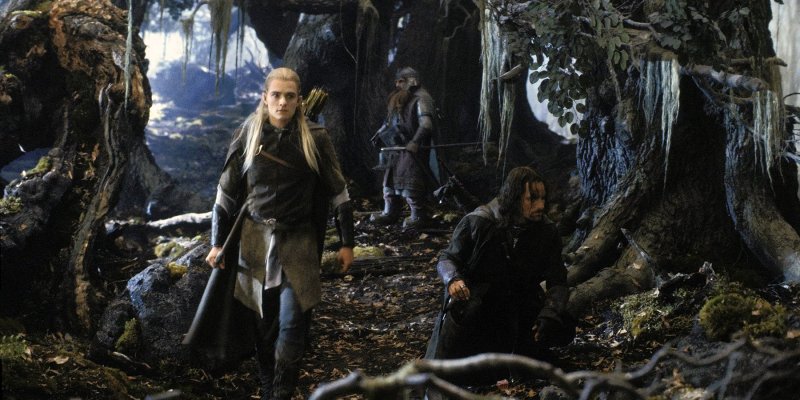This is the second of three articles marking the 20th anniversary of the Lord of the Rings movie trilogy, with today’s discussion examining The Two Towers. Yesterday, we discussed why only Peter Jackson could have made The Lord of the Rings. Check back tomorrow for a discussion of how, despite the many endings of The Return of the King, The Lord of the Rings is itself one big ending.
The Lord of the Rings is so large that the adjective “epic” feels insufficient.
Historians have argued that J.R.R. Tolkien saw his work on the saga as “a work of historical reconstruction.” Commentators have drawn comparisons between Tolkien’s work and Richard Wagner’s epic opera cycle Der Ring des Nibelungen. Peter Jackson’s film trilogy was also epic in scale, with most of the three films shot in a production block running 274 days and involving 26,000 extras. The walled city of Minas Tirith was the largest set ever built in the Southern hemisphere.
However, this epic scale is contrasted with a compelling intimacy. At the heart of this mythic saga about the eternal battle between good and evil, The Lord of the Rings is a story about the importance of small acts of heroism. As significant as figures like Gandalf (Ian McKellen) and Aragorn (Viggo Mortensen) are to the larger story, the fate of Middle-earth ultimately comes to rest on the shoulders of Frodo Baggins (Elijah Wood) and Samwise Gamgee (Sean Astin).
Nowhere is this delicate balance more obvious than in The Two Towers, the middle installment of the trilogy. It’s the film in the saga that feels most swept up in the flow of the larger trilogy, most concerned with processing the scale of what is happening to Middle-earth and what that means for the individual characters caught in the pull of these competing forces.

The Two Towers was the most challenging of the three films for Jackson. The Fellowship of the Ring was “a straightforward, linear story,” which eased the audience into the world. The Return of the King was his favorite of the three because it “has a conclusion.” In contrast, The Two Towers was “a more complicated piece of storytelling.” The cast of the first film have been fractured by the start of The Two Towers and remain apart by the end. There’s no clear beginning and no neat resolution.
The Fellowship of the Ring had essentially been structured as a road movie. Gandalf entrusted Frodo with the eponymous piece of jewelry, tasking Frodo and Sam with bringing the ring to the Elven kingdom of Rivendell. A chance encounter brings Merry (Dominic Monaghan) and Pippin (Billy Boyd) into their party. Once the four Hobbits arrive at Rivendell, it is decided to form a team to take the ring to Mordor to destroy it. There are some really beautiful montages of the group traveling.
The Fellowship of the Ring has a fairly organic structure, with the eponymous group traveling from one place to another on their way to destroy the ring. They have a series of miniature adventures along the way: They confront a monstrous Balrog in the Mines of Moria and then meet some elves in the Wood of Lothlórien. They are then ambushed in the forest by the monstrous Uruk-hai. Boromir (Sean Bean) is killed. Pippin and Merry are captured. Frodo and Sam strike out on their own.
This fracturing of the fellowship gives The Two Towers its core power. Frodo and Sam continue the journey to Mordor alone, encountering the untrustworthy Gollum (Andy Serkis). Aragon leads Legolas (Orlando Bloom) and Gimli (John Rhys-Davies) to rescue the kidnapped Merry and Pippin. However, Aragorn is quickly drawn into the politics of Rohan while Merry and Pippin find themselves negotiating with the tree-like Ents to build the alliances necessary to preserve Middle-earth.

Tolkien was never especially concerned with the politics of Middle-earth, but The Two Towers explores what has been happening outside the small cast of the previous film. The people of Rohan have been subjected to aggressive raids by orcs. The evil wizard Saruman (Christopher Lee) has infiltrated the kingdom through the manipulations of royal advisor Gríma Wormtongue (Brad Dourif), and enthralled King Théoden (Bernard Hill). Saruman is also burning the forests to prepare for war.
The scale and the stakes of The Lord of the Rings can sometimes seem so large as to be abstract. The title character is a disembodied representation of fascism named Sauron (Alan Howard), whose primary attributes are “his cruelty, his malice, and his will to dominate all life.” The heroes naturally stand opposed to this. The fate of the world hangs in the balance, along with even less concrete concepts like free will and self-determinism. The ring is power in its purest and most notional form.
The Two Towers feels like an effort to ground the stakes of this conflict in more relatable terms. Given that Minas Tirith is largely abandoned when Gandalf visits it in The Return of the King, and Jackson decided not to include the Scouring of the Shire, The Two Towers is the only point at which the film trilogy really dwells on the immediate civilian toll of Sauron’s war. Aragorn finds himself enlisted to protect the women and children of Rohan from Saruman’s armies. This feels like a story set during a war, not an epic adventure.
In contrast to the two films either side of it, The Two Towers seems rather less mythic. The wizard Gandalf is much less active in the plot of The Two Towers than he is in the narratives of either The Fellowship of the Ring or The Return of the King. It is notable that The Two Towers is the only film in the original trilogy in which the voice of Sauron is not heard. The presence of these two actors is felt, but there’s more focus on the consequences of their machinations.

The Two Towers is much more invested in the human emotion of all this. Although Arwen (Liv Tyler) was introduced in The Fellowship of the Ring, it is The Two Towers that delves into the implications of her love affair with Aragorn. Both characters are asked to confront what it means for an immortal elf to love a mortal human. Aragorn even seems caught between the abstract ideal of his love of Arwen and the more material possibility of a romance with Éowyn (Miranda Otto).
In The Fellowship of the Ring, lines were clearly drawn between good and evil, particularly in relation to the ring. Aragorn, Gandalf, and Galadriel (Cate Blanchett) all refuse to take the ring from Frodo, recognizing their own fallibility and so affirming their heroism. The only member of the fellowship tempted by the ring is Boromir, whose desire is so obvious that even Galadriel can call it. Boromir tries to steal the ring from Frodo in the forest, and his death is a form of immediate redemption.
The characters in The Two Towers have more dimensionality. Although Gollum reveals himself to be a monster in The Return of the King, much of The Two Towers hinges on the fact that he both “hates and loves the ring — as he hates and loves himself.” The otherwise angelic Legolas is allowed a moment of doubt and weakness in Helm’s Deep, warning Aragorn that the refugees “are all going to die.” Even after he is freed from Saruman’s influence, Théoden struggles with the right thing to do.
The characters are motivated by tangible desires. Even Wormtongue does not serve Saruman out of some philosophical ideal or because of some genetic predeterminism, but because he lusts after Éowyn. When Boromir’s brother Faramir (David Wenham) captures Frodo, he is tempted to take the ring. However, he does not seek the ring for some abstract notion of power. Instead, he sees taking the ring as a way of earning the approval of his distant father Denethor II (John Noble).

Faramir is one of Jackson’s biggest deviations from the source novel, and this characterization remains controversial among Tolkien fans. In the book, Faramir is noble and virtuous; he is not drawn to the ring. Jackson has acknowledged this change was at least partially pragmatic, part of stalling Frodo’s plot in The Two Towers so it flowed more easily into The Return of the King, because otherwise “there’d be very little for Frodo and Sam to do” in the trilogy’s final installment.
However, this characterization of Faramir taps into what makes The Two Towers so compelling. So much of Tolkien’s writing is absolutist. People are good or evil, great or terrible. Characters either have the strength to immediately reject the ring or they greedily covet it with all their being. Faramir offers a more nuanced take. He is more seriously tempted by the ring than Aragorn or Gandalf, but he ultimately finds the resolve to do the right thing in spite of that temptation.
Although Tolkien would deny it, The Lord of the Rings has often been read as an allegory for the First World War or the Second World War. Perhaps the movie trilogy resonated with audiences because it connected with anxieties around the War on Terror. The Two Towers understands that such wars are not fought by gods or demons, by myths or legends. Instead, they are fought by people in all their imperfection – their hopes and fears, their strengths and weaknesses, their desires and doubts. The victims are those displaced and driven out.
It is too much to suggest that The Two Towers challenges the rigid moral order of Tolkien’s world. Sauron and the orcs are still an absolute evil. However, The Two Towers marks the one point in the saga where the fate of Middle-earth seems truly in doubt, with even Jackson acknowledging how hard it is to maintain dramatic tension as the heroes rack up victory after victory from Helm’s Deep into The Return of the King. (Jackson has argued that, dramatically, Minas Tirith should have been “a total defeat.”)
The Two Towers allows a messiness and ambiguity surrounding the saga’s would-be heroes. It brings a little humanity to Middle-earth.
